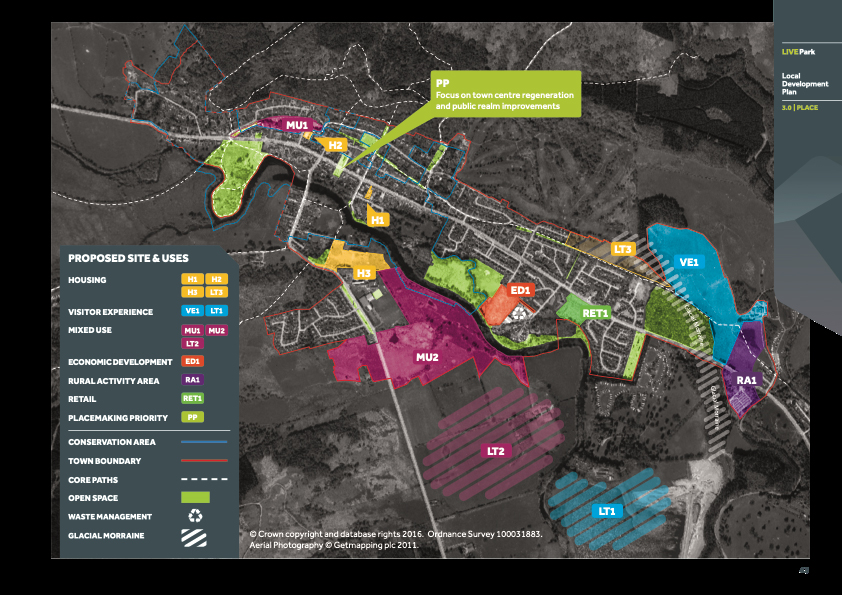

Past and Present Development Planning for Callander
Introduction
Here we look at the expansion plans that have been made for Callander since 2011. This section is solely about development because Callander’s Local Place Plan gives us an opportunity to have our say about the current plans to expand the town. This is the first opportunity for our community since 2011 to consider the impact on our lives that expansion of the town might have, and to make considered, rational, choices for our future.
The old Community Action Plans did not allow us to have any meaningful input in this area. Instead, they focussed on economic, structural, and societal changes.
2011 The Charrette
The Charrette was the largest public consultation to date on Callander’s future development. In terms of new housing, we said we wanted more affordable homes for local families and we agreed that building new homes on the south bank of the Teith was probably the best solution for an integrated, accessible town. This did not include building new housing next to the Mollands Estate, it expressly focussed on development on the land along south bank of the river.
The community asked for a new footbridge, to allow safer access to the McLaren Campus along with public green recreational spaces on both sides of the river, with any new housing planned to allow space for the continuous green corridor. We also said that we wanted more community facilities next to the McLaren Campus, including an outdoor activity hub and open space to provide a range of facilities for residents and visitors alike.
The land allocated for the community hub in the Charrette has now been developed for affordable housing.
Callander Charette Report (PDF)
2015 Callander South Masterplan
The plan was produced by the Park for ‘landowners, applicants/agents, developers, architects, as well as members of the public.’ It concentrates on the land at Claish Farm and Churchfields.
Although the Masterplan cites the Charrette as providing evidence of the need to develop more housing no regard has been paid to the extensive (and expensive) community consultations that shaped the Charrette. The masterplan overlooks many of our community wishes. Although the document does indicate that a green corridor is required along the south bank of the river, it appears as a green ‘buffer’ strip, rather than landscaped recreational space.
The National Park Local Development Plan 2017-21
Although the Charrette was mentioned within the 2017 document few, if any, of the community’s wishes were incorporated into the Park document. The green corridors have vanished, replaced with narrower flood mitigation zones. Housing is now also planned along the north side of the A81 next to the Mollands Estate. Any community hub or space has been gone, replaced with a ‘visitor experience’. Three additional sites are earmarked for ‘visitor experiences’ at Cambusmore, the eastern section of Claish Farm, and Auchenlaich. Great for visitors but little evidence of provision for residents.
Where we are now
The Park’s 2017-21 Development Plan has not been updated and so still carries weight. The intended development outcomes of the existing plan are as follows
New Housing - proposed
- 30 at Churchfields H3
- 22 at Balgibbon Drive LT3
- 90 homes at Claish Farm West MU2 – 50 have now been built.
- 100 at Claish Farm East LT2 (long term aim)
Visitor Experience
- Claish Farm West MU2
- Auchenlaich VE1
- Cambusmore LT1
- Claish Farm East LT2
Economic Development
- Lagrannoch Industrial Estate ED1
- Claish Farm West MU2
Retail Development
- Station Road car park overflow area MU1
- Field at Stirling Road RET1
Rural Development
- Callander East RA1

Stirling Economic Development Plan (Tourism)
In 2018 Stirling Council commissioned consultants to provide a series of options for tourist development in Callander South. The consultation was detailed and well considered. The consultants outlined 3 options one of which, based loosely on ‘a Centre Parc type facility’, was included at the insistence of Stirling Council. In their final report the consultants stated: “In terms of the economic impact of a Center Parcs village, it is clear from the academic research that most guests stay in the village without venturing off-site during their stay. A relatively small proportion of guests visit other places.”
The consultants recommended option was to create an attraction loosely based on the Rheged Centre in Cumbria
The full report was not shared with our community organisations. Instead, they were shown a PowerPoint presentation outlining the three options. The community organisations rejected all 3 as unsuitable.
We put in a freedom of information request in 2020 to ask Stirling if there had been any further developments and asked for the full consultant’s report(s). When they responded most of the email correspondence was so heavily redacted that it was impossible to understand. However, we did note that Stirling had been speaking to a possible investor in 2020 - a distillery looking for a visitor experience site.
At no point since 2019 have our community groups been informed about, or consulted on, any current discussions with potential visitor attraction developers.
The Charrette, revisited
The LLTTNP Local Development Plan clearly indicates that any infrastructure (paths, roads, or bridges) would need to be paid for by any developer who wants to build along the A81. This means no action will be taken to improve the connection between the north and south banks of the river, or to upgrade the existing paths until new housing or visitor attractions are built. Stirling Council confirmed (by email) that the estimated cost of building a road bridge at Geisher Road is around £10.8 million. This does not include the cost of the connecting the bridge to the A84.
If all 192 houses planned for Callander were built, the cost of the road bridge would equate to around £56,250 per house. It would be foolish to assume that planning gain at that inflated level is achievable. Logic would suggest that the bulk of the costs to build the bridge would be expected to come from the visitor attraction(s) on the A81 and so we are presented with a stark possibility: if Callander wants a road bridge, Callander must accept a large-scale tourist attraction.
We think there is a better, more cost-effective way to connect the town. A simple footbridge connection with upgraded, accessible paths along the south bank of the river would cost in the region of £2.5 million.
-
Creating the crossing now would delay the need for a road bridge, providing a positive benefit to the public purse.
-
The planning gain for any new housing along the A81 could be rationalised without the need to immediately contribute to toward the cost of the road bridge.
-
Limiting the timing of new build housing would control the pressures at the junction of Main Street and Bridge Street. Currently there is capacity for an additional 70 houses to use the junction.
-
The footbridge could be scoped, designed, and built within 18 months of approval.
-
Stirling has £2.5 million set aside under the City Deal for promoting tourism in Callander. This could be used to improve connectivity, giving tourist and walkers improved access to our stunning river view walks. When we asked how this money was to be spent, we were told that it would be used to “fund feasibility studies”.


